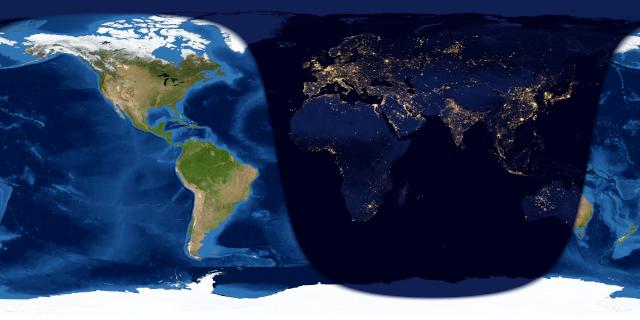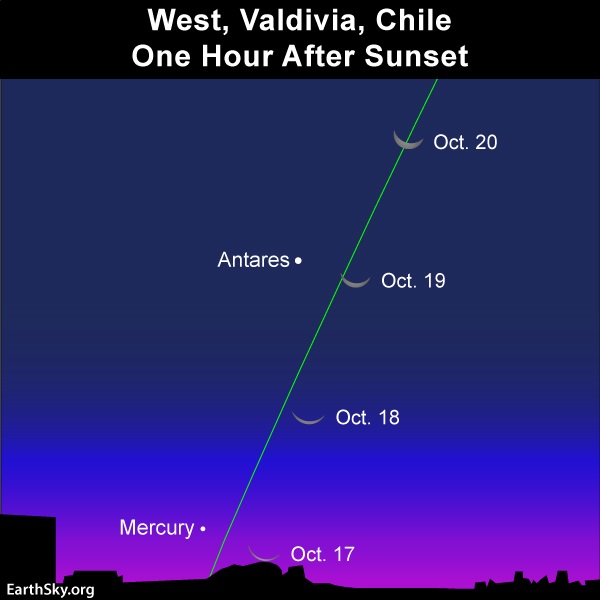The closest new moon of the year was October 16, 2020, at which time the moon was transitioning out of the morning sky and into the evening sky. On October 17, some people might spot the young moon’s rebirth at day’s end. If you do see it, the moon will be low in the west, in the glow of sunset. Be forewarned … this young, pale, fragile crescent after sunset October 17 will be a challenge to spot, even with binoculars, especially from Northern Hemisphere locations. It’s hard to spot a young moon that’s less than a day old (less than 24 hours after new moon), especially in the autumn. If you want to try your luck on October 17, be sure to find an unobstructed horizon in the direction of sunset. Find a hilltop if you can. Bring along your binoculars!
Southern Hemisphere viewers will have an easier time spotting the young moon on October 17 than those of us north of Earth’s equator. That’s because it’s spring now in the Southern Hemisphere, and springtime young moons are the easiest to see.
From everywhere worldwide, the young moon will appear as a fatter crescent, farther from the sunset and easier to spot, on the evenings of October 18, 19 and 20. Day by day, a wider lunar crescent will appear higher up at sunset and will stay out longer after sundown.
Want to know when the moon sets in your sky? Visit Sunrise Sunset Calendars and remember to check the moonrise and moonset box.

Because the new moon on October 16 was closely aligned with perigee – the moon’s closest point to Earth in its monthly orbit – the moon is now orbiting Earth at a maximum speed. On the average, the moon travels eastward in front of the backdrop stars of the zodiac at 13 degrees per day, and the young moon travels eastward of the sun at 12 degrees per day. (For reference, the moon’s angular diameter spans about 1/2 degree.)
Right now, however, the moon is traveling faster than average! It is moving 15 degrees per day relative to the backdrop stars, and 14 degrees per day relative to the sun.
Click on Heavens-Above to know the moon’s present position in front of the constellations of the zodiac.
Click on Heavens-Above to know the sun’s present position in front of the constellations of the zodiac
This faster-moving moon benefits the world as a whole in the hunt for the young moon. Unfortunately for northerly latitudes, however, the ecliptic – the moon’s monthly pathway – crosses the horizon at a narrow angle at sunset and early evening. The autumn angle of the ecliptic buries the young moon in the glare of evening twilight. Although the moon will be over one day old at sunset October 17 in North America, it’ll still be hard to catch the lunar crescent on this date due to the ecliptic’s shallow autumn angle.
It’s spring now in the Southern Hemisphere, however. And, in springtime, the ecliptic – the monthly pathway of the moon – intersects the horizon at a steep angle at sunset and early evening. Therefore, in South America, the moon is higher up in the sky at sunset and stays out longer after sundown than it does in North America. That’s why we expect South American countries with clear skies and unobstructed western horizons to have a good chance of catching the young moon after sunset on October 17.

See the chart immediately above for Valdivia, Chile. Valdivia, Chile (40 degrees south latitude) and Philadelphia, Pennsylvania (40 degrees north latitude) and pretty much reside on the same longitude (75 degrees west). On early spring evenings, the ecliptic – pathway of the sun, moon and planets – hits the evening horizon at a steep angle; and on early autumn evenings, the ecliptic intersects the evening horizon at a narrow angle. Since it’s now early spring in the Southern Hemisphere and early autumn in the Northern Hemisphere, the steeper angle of the ecliptic in Valdivia keeps the moon (and the planet Mercury) out longer after sundown than in Philadelphia.
For October 17, 2020
Valdivia (40 degrees south latitude):
Moon sets 75 minutes after the sun (October 17)
Mercury sets 84 minutes after the sun (October 17)Philadelphia (40 degrees north latitude):
Moon sets 55 minutes after the sun (October 17)
Mercury sets 27 minutes after the sun (October 17)
See why you might or might not catch the young moon after sunset October 17? If you do, enjoy it! Then expect the young moon to become more picturesque – and easier to see – in the following evenings, as a brighter, wider crescent. Watch for earthshine softly illuminating the dark (nighttime) side of the moon. Earthshine is twice-reflected sunlight, first reflected from the Earth to the moon, and then from the moon back to Earth.
Bottom line: You might or might not see the moon on October 17, 2020. But you’ll more easily catch it on October 18, 19 or 20. Look west after sunset!











